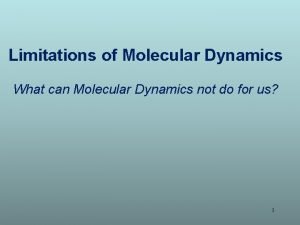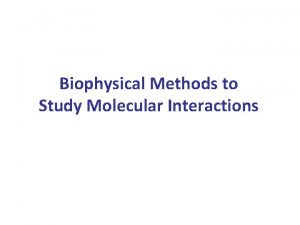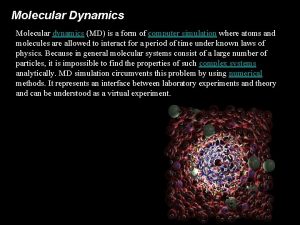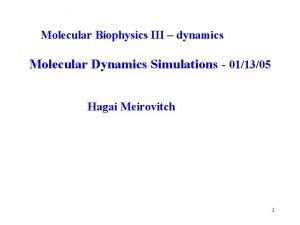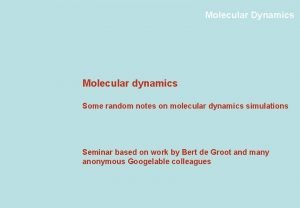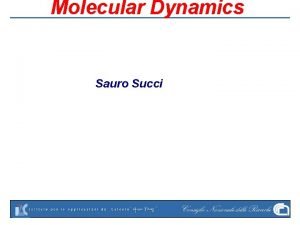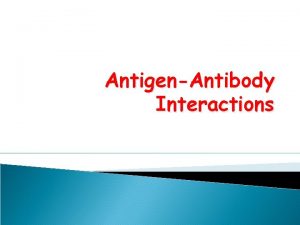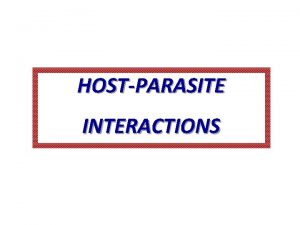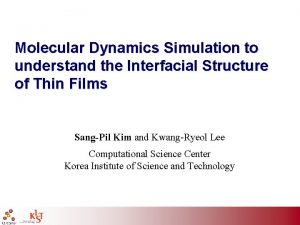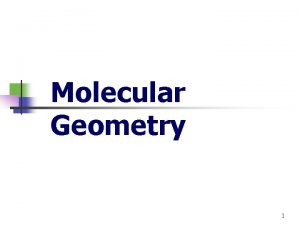Molecular Interactions To understand molecular structure and dynamics














- Slides: 14

Molecular Interactions • To understand molecular structure and dynamics, we need a basic understanding of the forces (interactions) between and within macromolecules • We start with energy ideas – the total energy is made up of kinetic [1/2 mv 2=p 2/(2 m)] and potential energy • Forces (F = ma) can be found from potential energies, V(x, y, z) (in 1 -D: ) • Potential energies are all due to electrical interactions

Types of Interactions • The total potential energy of a single macromolecule can be divided into Vbonding and Vnonbonding parts. The bonding energies are due to the local covalent bonds • All bond energies can be expanded in a series: • But we can pick V(ro)=0 and at ro, F = 0, so and bonding forces acts just like a spring.

Interactions II • The same analysis works for bond stretching/compression as above and for bending or twisting, where r is replaced by q • Nonbonding interactions vary inversely with distance – the most familiar is Coulomb’s force law giving • Here D = dielectric constant = 80 for water • Note – no charge shielding is included here – we will see this soon

Electric Dipole • Equal and opposite charges make an electric dipole m=qd (direction from – to +) (water) • Charge-dipole interaction: • Dipole-dipole interaction: • Special type of dipole-dipole is the H-bond • Dipoles can be induced by charges

van der Waals (London or dispersion) Interactions • With no charge or permanent dipole, two atoms can still electrically interact – fluctuating dipole – induced dipole interaction where a is polarizability of atom • Hard-sphere repulsion at shorter distances – a quantum phenomenon with V~1/r 12 • Common model potential is 6 -12 or Lennard-Jones:

Water • Water is a very special solvent with unusual properties – it makes up ~70% of human body weight • Some properties of water – High dielectric constant – lowers V between charges – High heat capacity – thermal buffer from metabolic activity – High heat of vaporization – perspiring cools effectively – Higher density than ice below 4 o. C – High surface tension – need surfactants in lungs to decrease work needed to keep alveoli open • Water forms lots of H-bonds with other water molecules leading to cooperative formation of aggregates – each O is, on average, bound to 4 H’s with 2 covalent and 2 non-covalent bonds

Hydration • Bound water on a macromolecule forms a “hydration shell” with different physical properties from bulk water • On average 0. 3 – 0. 4 gm water/gm protein • Non-polar groups tend to aggregate and exclude water, thus minimizing the energy of interaction

Hydrophobic Effect • Near non-polar surfaces, water molecules re-orient themselves – still form 3 – 4 bonds/water molecule, but this more highly ordered structure is entropically unfavored • Entropy ideas – minimize order = maximize entropy The hydrophobic effect arises from a peculiarity of water structure. Water molecules form strong Hbonds with their neighbors, but exchange these bonds at a rate of about 1011 s-1. At the interface between water and a non H-bonding group such as -CH 3, there are fewer opportunities for H-bond exchange. This leads to longer H-bond lifetime, and creation of ice-like ordered water clusters at the interface, and consequent loss of entropy.

Small Ion Effects • Ion-solvent interactions – Born model – Ion = rigid sphere of charge – Solvent = structure-less continuum – Interactions are all electrostatic – Can calculate free energy required • Ion-ion interactions – surface charge groups on a macromolecule (at neutral p. H these are COO-, NH 3+, HPO 4 -) attract a layer of “counterions” – These charges screen the macromolecule charges, depending on the ionic strength – Need some physics here to model this

Charge Screening (Debye-Huckel) Outline of 1 dimensional calculation: – Start with Gauss’s Law – Derive Differential equation for potential V(x) – Assume charge density determined by Boltzmann distribution – Get non-linear differential equation – When charge interaction energy <<k. T, the equation is linear and we can solve it – Solution is: V(x) = V(0) e-kx, where k = 1/distance = 1/Debye screening length and is given by

Summary of Important Non-covalent Bonding Ideas for Macromolecules • Non-covalent bonding determines everything beyond primary structure • Most important are – Ionic (charge/dipole) – p. H and salt dependent; especially strong in Asp, Glu, Lys, Arg – Hydrophobic – especially Phe, Leu, Ala – Hydrogen • Non-covalent bonds are individually weak, but collectively strong

Molecular Dynamics How do all the atoms of this hemoglobin molecule move around in time? They undergo random thermal motions, known as diffusion, and each atom responds to all the forces acting on it according to Newton’s laws. The problem is that there are many atoms in hemoglobin and many solvent molecules that collide with them and need to be accounted for. Early crystal x-ray diffraction structures were pictured to be static – but really the atoms move about quite a bit

Mol. Dynamics 2 • In one dimension the acceleration of the ith atom is given by: From this we know that for a small time step (typically less than 1 ps = 10 -12 s) and Adding these While subtracting them gives So if we know the forces and starting positions, we can iterate and predict the motion of each atom

Mol. Dynamics 3 • Molecular dynamics calculations are computer intensive – for each time step (sub – ps) you need to do several calculations for each atom in the molecule. • For a reasonable protein (several 100 amino acids – or thousands of atoms) it takes many hours of supercomputing to map out the motions for nanoseconds • Fast laser dynamic experiments are just starting to actually measure time courses of individual molecule motion in picoseconds • NIH molecular dynamics movies/
 Role of quantitative research
Role of quantitative research Melting and boiling point of oxygen
Melting and boiling point of oxygen Ionic covalent metallic
Ionic covalent metallic Giant molecular structure vs simple molecular structure
Giant molecular structure vs simple molecular structure To understand recursion you must understand recursion
To understand recursion you must understand recursion Molecular dynamics limitations
Molecular dynamics limitations Interactions between ais and internal and external parties
Interactions between ais and internal and external parties Structure and dynamics of personality
Structure and dynamics of personality Contractionary monetary policy
Contractionary monetary policy The properties and interactions of magnets
The properties and interactions of magnets Sphere interactions
Sphere interactions 6.1 niches and community interactions answers
6.1 niches and community interactions answers Examples of integral product architecture
Examples of integral product architecture Factors that affect the communication process
Factors that affect the communication process Symbiosis and species interactions keystone webquest
Symbiosis and species interactions keystone webquest





